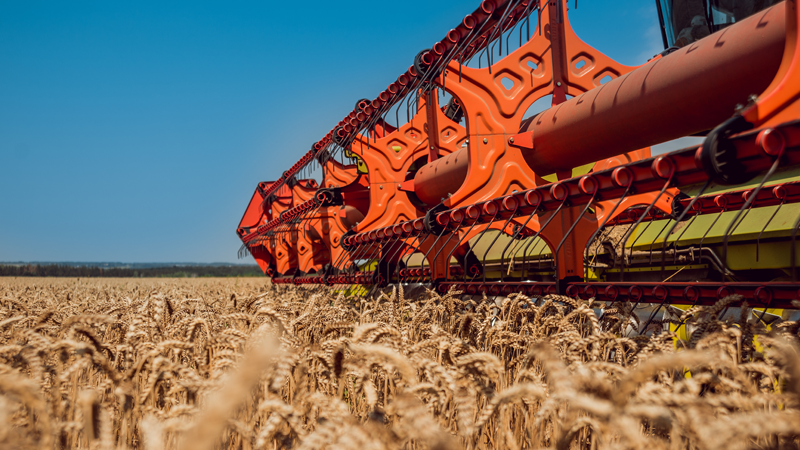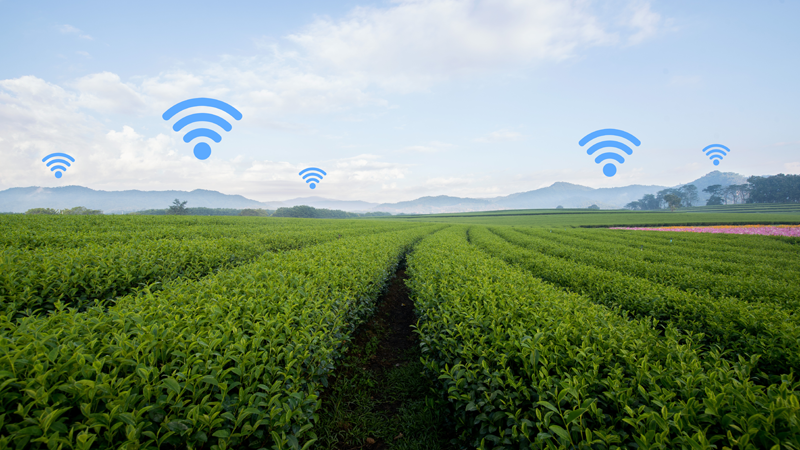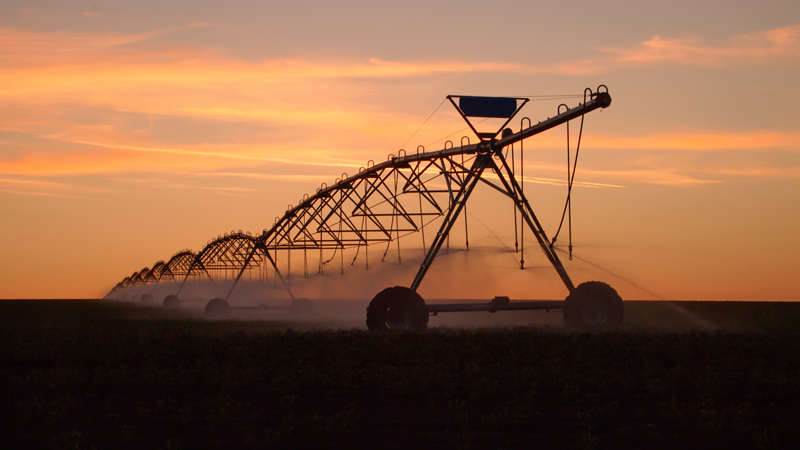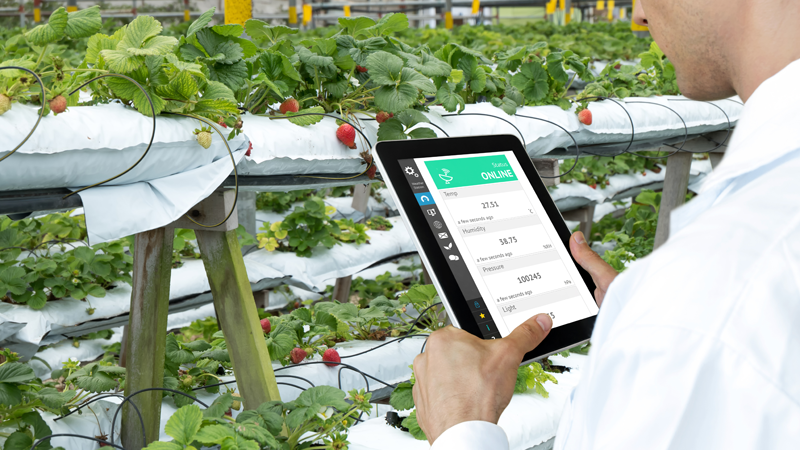Field Internet of Things
According to forecasts, closer to 2050, humanity will need 70% more food to supply than today. But the worsening environmental situation, the rising cost of energy and the fall in land fertility will be a serious obstacle to the production of the necessary amount of food. These problems can be solved by changing the methods of agricultural activities, in particular, introducing the latest technologies and innovative solutions, like the concept of the Internet of things.

Despite the fact that agriculture seems to be a rather conservative industry due to the specifics of production, it is one of the first to use IT technologies, and in particular, the Internet of Things (Internet of Things, IoT). Recall, IoT is understood as a global concept of interaction and exchange of information by various devices, machines, systems via the Internet. It allows to reduce human participation at some stages of production, by automating the process and controlling it through various “smart” devices.
Studies show that the most active IT-technologies are used in field agriculture in growing crops. With the use of "smart" devices, it became possible to introduce so-called. “Precision farming” - management of the productivity of crops, taking into account changes in the habitat of plants. Ultimately, this makes it possible to solve two main tasks of agricultural producers - increasing yields and reducing costs. However, such innovations are still gaining popularity. According to the US Department of Agriculture (USDA), on average, the level of use of the same precision farming technology in this country ranges from 30% to 50%, depending on the region. And this, we note, is one of the leading countries in the use of IT technologies in various industries.

Nevertheless, analysts from the Goldman Sachs Group argue that most countries, actively developing their agriculture, are moving smoothly from the "analog" to the "figure." According to their forecasts, the use of new technological solutions is able to increase global agricultural production by 70% by 2050, which will bring additional agricultural products by almost $ 800 billion.
But in order for all this to work, we need other machines and units. And it should be noted that their manufacturers are massively beginning to switch to the production of products that can become part of IoT. Leading global companies operating in the field of agro-machinery production are already building their development strategies based on the need for digitalization and automation of most agricultural processes. Illustrative in this context is the example of Germany, which, at the state level, has embarked on the digitalization of industry.

It should be noted that, in general, Europe is still lagging behind the United States in terms of the use of “smart” devices in the agro-industrial sector. Despite the fact that in the EU about 80% of agricultural equipment is already sold with navigation systems, no more than 30% are actually connected to the network. The reason for this is a much smaller share of large farms than in the USA. In Europe, small family farms predominate, which already have enough equipment and are not in a hurry to change it to “smart”, which means more expensive.
In the post-Soviet space, in particular, in the countries of active agricultural production (Russia, Ukraine, Belarus, Kazakhstan), the main users of new technologies are large agro-industrial complexes, as a rule, with private capital. The main obstacles to the use of “smart” devices in the agricultural sector of these countries, in addition to the financial component, are insufficient infrastructure development and 3G / 4G wireless communication coverage, as well as a rather large energy intensity of existing technologies. However, the prospects that the introduction of IoT technologies in the agro-industrial sector (increasing the volume of communication services, traffic, customers, etc.) promises to mobile operators will sooner or later force them to rebuild the network infrastructure. It is quite possible that the expected appearance of a new communication standard 5G by 2020 will be a strong impetus to this.
What kind of “breakthrough” solutions can the Internet of Things provide for the agrosphere? In addition to the main ones - increasing yields and reducing costs, with the help of IoT devices you can implement a whole range of other solutions that directly affect the process of agricultural production. This could include remote control of agricultural equipment and technological operations, control of various processes and states and much more.
According to a special program, unmanned agricultural machines can automatically carry out both tillage and harvesting. Their use will automate almost the entire agricultural cycle. This can be used not only ground "drones", but also aircraft. Armed with special cameras and highly sensitive sensors, they are able to inspect large fields in a short period of time. The information collected by them will make it possible to create an electronic 3D map of fields, calculate indicators for fertilizer application, monitor the operation of vehicles and agricultural machinery, protect land, etc. Also, many decisions concern the processing and storage of agricultural products. Automation of these processes allows to reduce personnel costs and improve the storage conditions of the harvested crop.

As you can see, here a special role is assigned to sensors and sensors. Features of the design and operation of these devices allows you to place them at significant distances and through the network, without a break, to receive information about the state of various fields and crops, in particular, the parameters of humidity, temperature, weed infestation, growth phases, etc.
But to obtain such information in the relevant region (locality) there must be a stable wireless communication, the quality of which allows to ensure the uninterrupted operation of the IoT devices involved in the system. No less important is the interaction between all participants of the IoT system: manufacturers, suppliers of relevant devices and services, developers of applications and solutions, their users, and, of course, the “smart” devices themselves. The platform that unites them all under one “roof” and enables “communication” is the corresponding IoT platform - the central component of the IoT ecosystem.

During the implementation of IoT solutions, due to the interaction of the IoT system participants among themselves, a certain ecosystem of partners will always be formed. The IoT platform acts as an intermediary through which devices and system components can exchange data.
In addition, it allows you to develop custom applications and services. This will have a very positive effect on the use of the IoT capabilities directly by users - farmers or farm personnel. Using the interface of the IoT platform and the general infrastructure, with the help of special designers, system users will be able to create their product and introduce their own innovations. For example, any farmer will be able to independently replace the “manual” process of analyzing the quality of soils, water, and weather conditions in a particular area of his land with a monitoring system by generating a task through the application designer. That is, by adding the appropriate module, construct virtually any set of solutions needed by a particular farmer and share them on a paid or free basis with others.

At the same time, the presence of a common platform, as it were, “socializes” the solution they have created, making it available to other consumers. And this will already mean a smooth transition to global multi-user platforms, the foundation of which is harmonious synergy of three components: social, content and hardware, which are called social IoT platforms (SIoT). Many experts believe that the future of “smart” agriculture in such platforms, while one of the decisive factors in popularizing the Internet of Things, including for the agricultural industry, will be the social component.
In any case, the global trend to increase the amount of food gives the agrarian industry a good chance in a short time to turn from the traditionally conservative to high-tech, able to absorb the innovative solutions and developments that the concept of the Internet of things offers today.

"Smart" field, what is it?
Despite the fact that agriculture seems to be a rather conservative industry due to the specifics of production, it is one of the first to use IT technologies, and in particular, the Internet of Things (Internet of Things, IoT). Recall, IoT is understood as a global concept of interaction and exchange of information by various devices, machines, systems via the Internet. It allows to reduce human participation at some stages of production, by automating the process and controlling it through various “smart” devices.
Studies show that the most active IT-technologies are used in field agriculture in growing crops. With the use of "smart" devices, it became possible to introduce so-called. “Precision farming” - management of the productivity of crops, taking into account changes in the habitat of plants. Ultimately, this makes it possible to solve two main tasks of agricultural producers - increasing yields and reducing costs. However, such innovations are still gaining popularity. According to the US Department of Agriculture (USDA), on average, the level of use of the same precision farming technology in this country ranges from 30% to 50%, depending on the region. And this, we note, is one of the leading countries in the use of IT technologies in various industries.

Nevertheless, analysts from the Goldman Sachs Group argue that most countries, actively developing their agriculture, are moving smoothly from the "analog" to the "figure." According to their forecasts, the use of new technological solutions is able to increase global agricultural production by 70% by 2050, which will bring additional agricultural products by almost $ 800 billion.
Change equipment and infrastructure
But in order for all this to work, we need other machines and units. And it should be noted that their manufacturers are massively beginning to switch to the production of products that can become part of IoT. Leading global companies operating in the field of agro-machinery production are already building their development strategies based on the need for digitalization and automation of most agricultural processes. Illustrative in this context is the example of Germany, which, at the state level, has embarked on the digitalization of industry.

It should be noted that, in general, Europe is still lagging behind the United States in terms of the use of “smart” devices in the agro-industrial sector. Despite the fact that in the EU about 80% of agricultural equipment is already sold with navigation systems, no more than 30% are actually connected to the network. The reason for this is a much smaller share of large farms than in the USA. In Europe, small family farms predominate, which already have enough equipment and are not in a hurry to change it to “smart”, which means more expensive.
In the post-Soviet space, in particular, in the countries of active agricultural production (Russia, Ukraine, Belarus, Kazakhstan), the main users of new technologies are large agro-industrial complexes, as a rule, with private capital. The main obstacles to the use of “smart” devices in the agricultural sector of these countries, in addition to the financial component, are insufficient infrastructure development and 3G / 4G wireless communication coverage, as well as a rather large energy intensity of existing technologies. However, the prospects that the introduction of IoT technologies in the agro-industrial sector (increasing the volume of communication services, traffic, customers, etc.) promises to mobile operators will sooner or later force them to rebuild the network infrastructure. It is quite possible that the expected appearance of a new communication standard 5G by 2020 will be a strong impetus to this.
Automation of everything and everyone
What kind of “breakthrough” solutions can the Internet of Things provide for the agrosphere? In addition to the main ones - increasing yields and reducing costs, with the help of IoT devices you can implement a whole range of other solutions that directly affect the process of agricultural production. This could include remote control of agricultural equipment and technological operations, control of various processes and states and much more.
According to a special program, unmanned agricultural machines can automatically carry out both tillage and harvesting. Their use will automate almost the entire agricultural cycle. This can be used not only ground "drones", but also aircraft. Armed with special cameras and highly sensitive sensors, they are able to inspect large fields in a short period of time. The information collected by them will make it possible to create an electronic 3D map of fields, calculate indicators for fertilizer application, monitor the operation of vehicles and agricultural machinery, protect land, etc. Also, many decisions concern the processing and storage of agricultural products. Automation of these processes allows to reduce personnel costs and improve the storage conditions of the harvested crop.

As you can see, here a special role is assigned to sensors and sensors. Features of the design and operation of these devices allows you to place them at significant distances and through the network, without a break, to receive information about the state of various fields and crops, in particular, the parameters of humidity, temperature, weed infestation, growth phases, etc.
But to obtain such information in the relevant region (locality) there must be a stable wireless communication, the quality of which allows to ensure the uninterrupted operation of the IoT devices involved in the system. No less important is the interaction between all participants of the IoT system: manufacturers, suppliers of relevant devices and services, developers of applications and solutions, their users, and, of course, the “smart” devices themselves. The platform that unites them all under one “roof” and enables “communication” is the corresponding IoT platform - the central component of the IoT ecosystem.

IoT platforms: from agrarian to social
During the implementation of IoT solutions, due to the interaction of the IoT system participants among themselves, a certain ecosystem of partners will always be formed. The IoT platform acts as an intermediary through which devices and system components can exchange data.
In addition, it allows you to develop custom applications and services. This will have a very positive effect on the use of the IoT capabilities directly by users - farmers or farm personnel. Using the interface of the IoT platform and the general infrastructure, with the help of special designers, system users will be able to create their product and introduce their own innovations. For example, any farmer will be able to independently replace the “manual” process of analyzing the quality of soils, water, and weather conditions in a particular area of his land with a monitoring system by generating a task through the application designer. That is, by adding the appropriate module, construct virtually any set of solutions needed by a particular farmer and share them on a paid or free basis with others.

At the same time, the presence of a common platform, as it were, “socializes” the solution they have created, making it available to other consumers. And this will already mean a smooth transition to global multi-user platforms, the foundation of which is harmonious synergy of three components: social, content and hardware, which are called social IoT platforms (SIoT). Many experts believe that the future of “smart” agriculture in such platforms, while one of the decisive factors in popularizing the Internet of Things, including for the agricultural industry, will be the social component.
In any case, the global trend to increase the amount of food gives the agrarian industry a good chance in a short time to turn from the traditionally conservative to high-tech, able to absorb the innovative solutions and developments that the concept of the Internet of things offers today.
All Articles